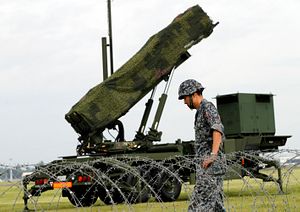Japan is taking a wait-and-see approach before it alters its fundamental assessment of the security dangers posed by North Korea’s nuclear and missile capabilities.
In the 2018 defense white paper, published on Tuesday, Japanese officials say that despite the flurry of international negotiations since the start of the year, “there is no change in our basic recognition concerning the threat.”
The assessment comes as U.S. President Donald Trump tempers his initially rosy outlook on the outcome of his summit meeting with North Korean leader Kim Jong Un in Singapore in June. In the Trump-Kim joint statement, North Korea committed to “work toward complete denuclearization of the Korean Peninsula” but the deadlines and time frames were left for subsequent negotiations.
Upon his return to the United States, Trump tweeted: “There is no longer a Nuclear Threat from North Korea.” Trump subsequently argued that the denuclearization deal was “being praised and celebrated all over Asia.” However, last week, Trump canceled a planned trip to Pyongyang by Secretary of State Mike Pompeo and conceded that American negotiators were not making sufficient progress. As Ankit Panda has pointed out on these pages, North Korea will continue its diplomatic outreach to South Korea and China, even if the U.S. talks are at a roadblock.
Defense of Japan 2018, published by the Japan’s Ministry of Defense, lays bare the sober assessment of officials in Tokyo. While describing the written promise by Kim as “significant,” the document emphasizes that it is important to keep watching for “specific actions” by the regime to eliminate its nuclear and missile capabilities.
“Meanwhile, taking into consideration the fact that North Korea appears to possess and deploy several hundred Nodong missiles capable of reaching almost every part of Japan, as well as advancements in the development and operational capabilities of nuclear weapons and missiles through repeated nuclear tests and ballistic missile launches to date, there is no change in our basic recognition concerning the threat of North Korea’s nuclear weapons and missiles,” says an English summary circulated by the Ministry of Defense.
The white paper notes that since 2016, North Korea has conducted three nuclear tests and launched as many as 40 ballistic missiles. These military trends, it says, “pose an unprecedentedly serious and imminent threat to Japan’s security, and significantly damage the peace and security of the region and the international community.”
Japan assesses that North Korea’s sixth nuclear test, conducted in September of last year, had an estimated yield of 160 kilotons – its largest yielding test to date. The white paper says it is “difficult to deny the possibility that it was a hydrogen bomb test.” It adds: “Considering the technological maturity estimated to have been achieved through these six nuclear tests, it is possible that North Korea has already achieved the miniaturization of nuclear weapons and has developed nuclear warheads so that nuclear weapons can be loaded into ballistic missiles.”
Focusing on the threat posed by ballistic missiles, the white paper says North Korea appeared to be aiming to: advance its long-rang ballistic missiles’ technological reliability; enhance the accuracy and operational capabilities necessary for saturation attacks; improve its ability to conduct surprise attacks; and diversify the forms of launches.
The written assessment is consistent with the Japanese government’s cautious public statements to date. Defense Minister Itsunori Onodera said at a press conference earlier this month that “dismantlement by North Korea of its nuclear and missile development is not concretely advancing following the U.S.-North Korea Summit Meeting.” He added: “As far as we are concerned, there has been no change to the threat, and we will make preparations as necessary.”
Indeed, the government is proceeding with plans, approved last December, to introduce the Aegis Ashore ballistic missile defense system to reinforce Japan’s ability to carry out upper-tier interception. The government has further signaled that it intends to update the National Defense Program Guidelines and the Medium Term Defense Program by the end of 2018.
Tokyo has repeatedly made clear that its view that international sanctions on North Korea should continue to be properly enforced. The defense white paper reiterates that the Japan Self-Defense Forces have already confirmed and made public nine cases of suspected illegal transfers of goods at sea involving North Korean vessels up to the end of June.
Meanwhile, the white paper canvasses another key focus of Japan’s defense planning: China. Using similar language as last year, the latest annual document notes that China’s rapid modernization of the People’s Liberation Army, enhancement of operational capabilities, and unilateral escalation of activities in areas close to Japan “are generating strong security concerns in the region and international community, including Japan.”
On the other hand, the document cites the introduction in June 2018 of Japan and China’s long-awaited maritime and aerial communication mechanism to avoid clashes in the East China Sea. Beijing is therefore “exhibiting interest in initiatives to avoid and prevent unexpected contingency in the seas and airspace and to promote mutual trust.”
While Tokyo and Beijing have made conspicuous moves to improve their long-strained relations in recent months, some analysts have previously questioned the durability of the rapprochement.

































